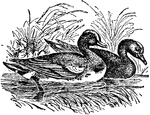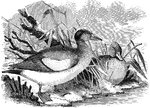Clipart tagged: ‘american wigeon’

Wigeon
"Wigeon is one of the most popular birds with the American sportsman. Length about eighteen inches;…

American Wigeon
"Mareca americana. American Wigeon. Bald-pate. Bill grayish-blue, with black tip and extreme base; feet…